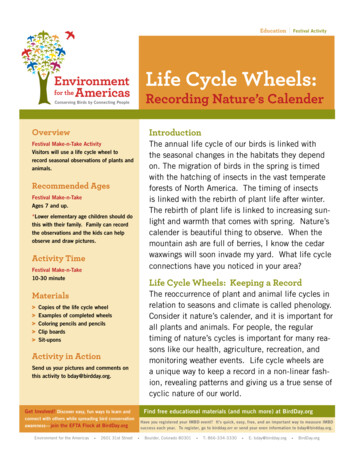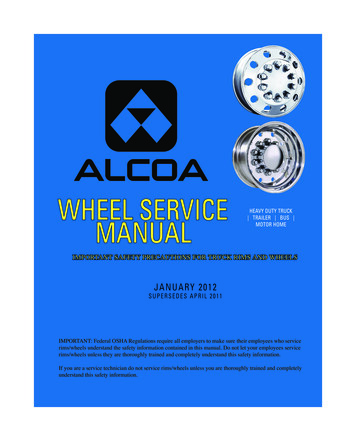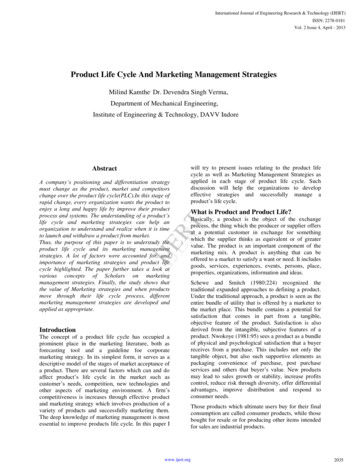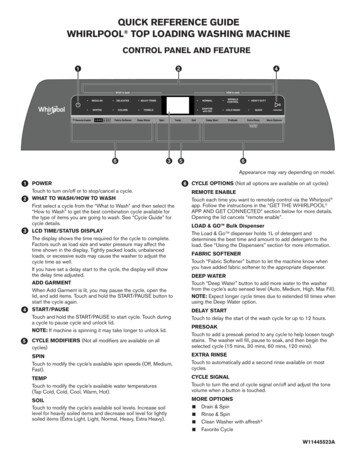
Transcription
EducationlFestival ActivityLife Cycle Wheels:Environmentfor the AmericasRecording Nature’s CalenderConserving Birds by Connecting PeopleOverviewIntroductionFestival Make-n-Take ActivityVisitors will use a life cycle wheel torecord seasonal observations of plants andanimals.The annual life cycle of our birds is linked withthe seasonal changes in the habitats they dependon. The migration of birds in the spring is timedwith the hatching of insects in the vast temperateforests of North America. The timing of insectsis linked with the rebirth of plant life after winter.The rebirth of plant life is linked to increasing sunlight and warmth that comes with spring. Nature’scalender is beautiful thing to observe. When themountain ash are full of berries, I know the cedarwaxwings will soon invade my yard. What life cycleconnections have you noticed in your area?Recommended AgesFestival Make-n-TakeAges 7 and up.*Lower elementary age children should dothis with their family. Family can recordthe observations and the kids can helpobserve and draw pictures.Activity TimeFestival Make-n-Take10-30 minuteLife Cycle Wheels: Keeping a RecordMaterials The reoccurrence of plant and animal life cycles inrelation to seasons and climate is called phenology.Consider it nature’s calender, and it is important forall plants and animals. For people, the regulartiming of nature’s cycles is important for many reasons like our health, agriculture, recreation, andmonitoring weather events. Life cycle wheels area unique way to keep a record in a non-linear fashion, revealing patterns and giving us a true sense ofcyclic nature of our world.Copies of the life cycle wheelExamples of completed wheelsColoring pencils and pencilsClip boardsSit-uponsActivity in ActionSend us your pictures and comments onthis activity to bday@birdday.org.Find free educational materials (and much more) at BirdDay.orgGet Involved! Discover easy, fun ways to learn andconnect with others while spreading bird conservationawareness—join the EFTA Flock at BirdDay.orgEnvironment for the Americas 2601 31st StreetHave you registered your IMBD event? It’s quick, easy, free, and an important way to measure IMBDsuccess each year. To register, go to birdday.orr or send your even information to bday@birdday.org. Boulder, Colorado 80301 T: 866-334-3330 E: bday@birdday.org BirdDay.org
Life Cycle WheelsEducationlInteractive ActivityPhenology & Climate ChangeThe warmer temperatures that are the result of climate change are causing many plants to flower earlier and insects to emerge sooner. While non-migratory birds may be able to adjust their activities totake advantage of changes in the availability of food resources, migratory birds must alter the timingof their long-distance journeys. If birds that winter in Mexico,the Caribbean, and Central and SouthAmerica do not change the timing of their departure to breeding sites in the United States and Canada,they may miss the insects and other foods on which they depend to help them migrate and to nest andraise young. Scientists call this phenomenon “mis-timing”. Already, researchers have learned thatsome bird species may need up to 35 years to shift the timing of their migrations, and that migratoryspecies require more time.Festival Make-N-Take Activity PreparationDownload and print the wheel, or order copies.Download the wheel at hemes-2013-education.The wheel is 11” by 11” so you may need to take it to a copy center to print. You can also order copiesthrough Environment for the Americas at www.birdday.org/shop. ( 1 per copy or 11.95 for 30 copies).Consider your supply of wheels and decide how you will distribute the wheels. For example, will you giveone for per family or one per visitor.Print the two examples included with this activity for display.Review how the information is recorded in the wheels referring to the examples and the diagram on page3. These are good examples to use when explaining how to use the wheel to visitors.Read through the activity then decide if this will be a self-guided experience or a staff-led activity.If it is self-guided, choose a place(s) you think best for visitors to sit to make and record observations.Make sure the observation areas are safe and free of poison ivy, red ants, etc. Why choose to make thisa staff-led activity? Staff could model and lead how to make observations and record them in the wheel.This option may be especially helpful for people new to your site and journaling.Gather Materials.Gather clip boards, pencils and colored pencils, and consider providing sit-upons, like carpet squares, tomake visitors comfortable while observing and recording on their wheels.EFTA Conserving Birds by Connecting PeopleFind free educational materials (and much more) at BirdDay.orgGet Involved! Discover easy, fun ways to learn and connect with others while spreading bird conservation awareness—join the EFTA Flock at BirdDay.orgEnvironment for the Americas 2601 31st Street Boulder, Colorado 80301 T: 866-334-3330 E: bday@birdday.org BirdDay.org
Life Cycle WheelsEducationlInteractive ActivityPresenting the Activity1. Introduce the Life Cycle WheelsLife cycle wheels are a unique way to look at the order of events. Rather than recording and viewingevents in a traditional time line or calender format, the wheels capture annual reoccurring cycles,allowing us to more readily see patterns and connections. The wheels can be used to record manycycles in nature: birds, blooms, phases of the moon, seasons, and more. You can record as much detail of your observations as you choose through words, drawings, pictures, or a mix of all.2. Explain how to use the wheel:Show visitors the 2 examples of completed bird life cycle wheels included with this activity. Begin inby pointing out the center of the circle that shows the theme of wheel. The theme can be a particularbird, a specific tree, or place. Move to the next ring of months to show how this area can be filled, withpictures or description or both, to record their observations. Point out that to capture what is blooming, buzzing, and singing that time of year, the best observations come from using your senses: sight,sound, smell, and touch. Do you hear the buzz of hummingbird wings? Do you smell fragrant flowers?Are the mosquitoes or black flies biting? What colors do you see? The more details that are captured inthe life cycle wheel, the more the changes over the months will stand out. Next, talk about the outermost ring and how it might be used to show seasons, or further details about the habitat or weather.Wrap-up by showing visitors a wheel you have started. Point out what you have recorded to give visitorssome ideas of what they might observe at your site.3. Give each visitor one wheel to cut out.Suggest they put their name on the back of the wheel. Review the parts of their blank wheel if needed,starting with the center. You might give the visitors some ideas for a focus theme for their wheel (center of wheel), or suggest that they look for inspiration once they are sitting quietly observing.4. Making and recording observations.Give visitors the option to make their first observations at your site, or take it home. If visitors chooseto make their first observation at your site, direct them to the areas you think best. You might even givethem ideas of something they can observe--maybe its a nest box or berry laden bush that birds andbugs are frequenting, or a pond. If you choose, offer sit-upons, pencils, and clip boards. Give them10 minutes, or long if they prefer, then give visitors the option to come back to your activity center tocolor their drawings and/or share their wheels. Discuss how they can continue to fill in the wheel eitherreturning to your site monthly, or choosing a particular place in their own yard.If visitors choose to take it home, discuss ideas for how to use it home--recording flowers blooming,insects, birds, and more in their backyards.EFTA Conserving Birds by Connecting PeopleFind free educational materials (and much more) at BirdDay.orgGet Involved! Discover easy, fun ways to learn and connect with others while spreading bird conservation awareness—join the EFTA Flock at BirdDay.orgEnvironment for the Americas 2601 31st Street Boulder, Colorado 80301 T: 866-334-3330 E: bday@birdday.org BirdDay.org
Life Cycle WheelsEducationlInteractive ActivityActivity Directions Continued5. ExtensionsPrint the mural of the life cycle wheel. Visitors could help fill in the wheel at your site over the courseof the year or staff can fill in the life cycle wheel so visitors can see what is going on at your site. Youcould use the life cycle murals to highlight different cycles at your site such as what’s in bloom, whatbirds are present & what they are doing, weather, sunlight, moon phases, insects, mammals,amphibians, etc.Parts of the WheelCenter: ThemeMiddle: Record of ObservationsOuter Circle: Additional detailsEFTA Conserving Birds by Connecting PeopleFind free educational materials (and much more) at BirdDay.orgGet Involved! Discover easy, fun ways to learn and connect with others while spreading bird conservation awareness—join the EFTA Flock at BirdDay.orgEnvironment for the Americas 2601 31st Street Boulder, Colorado 80301 T: 866-334-3330 E: bday@birdday.org BirdDay.org
Life Cycle WheelsEducationlInteractive ActivitySample Life Cycle WheelsSample wheels are provided by Partners in Place. See their web site for more ideas,www.partnersinplace.com.Partners in Place, www.partnersinplace.comEFTA Conserving Birds by Connecting PeopleFind free educational materials (and much more) at BirdDay.orgGet Involved! Discover easy, fun ways to learn and connect with others while spreading bird conservation awareness—join the EFTA Flock at BirdDay.orgEnvironment for the Americas 2601 31st Street Boulder, Colorado 80301 T: 866-334-3330 E: bday@birdday.org BirdDay.org
Life Cycle WheelsEducationlInteractive ActivitySample Life Cycle WheelsSample wheels are provided by Partners in Place. See their web site for more ideas,www.partnersinplace.com.nePartEFTA Conserving Birds by Connecting Peoplece,Planirsarw.pwwtnem.colacepnrsiFind free educational materials (and much more) at BirdDay.orgGet Involved! Discover easy, fun ways to learn and connect with others while spreading bird conservation awareness—join the EFTA Flock at BirdDay.orgEnvironment for the Americas 2601 31st Street, Boulder, Colorado 80301 T: 866-334-3330 E: bday@birdday.org BirdDay.org
Life cycle wheels are a unique way to look at the order of events. Rather than recording and viewing events in a traditional time line or calender format, the wheels capture annual reoccurring cycles, allowing us to more readily see patte










